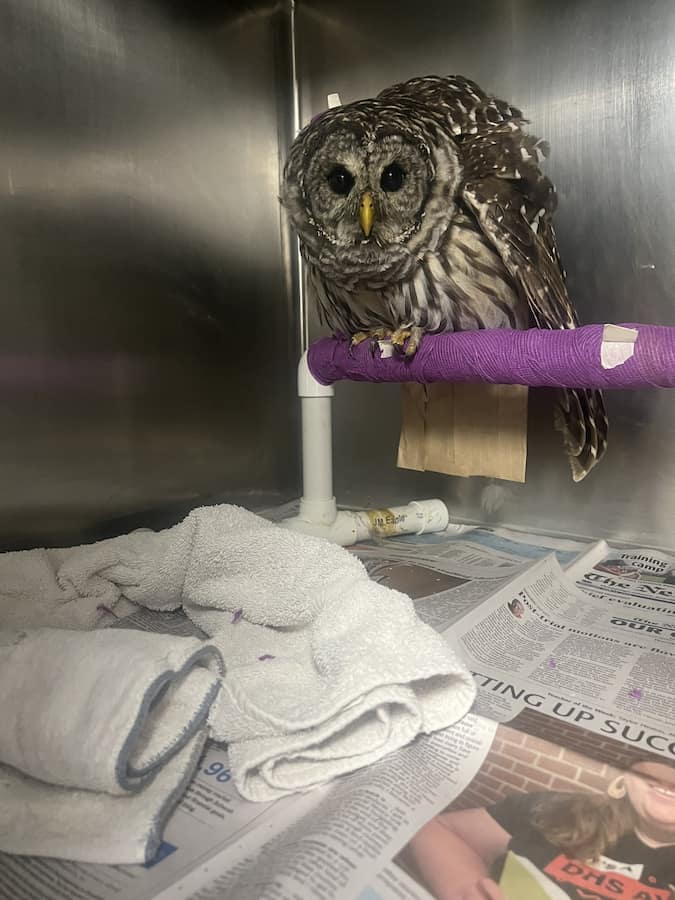
This year, an injured, adult common snapping turtle, Chelydra serpentina, was brought to the Wildlife Medical Clinic after being spotted with a fishing hook stuck through its tongue. Snapping turtles are native primarily to Central and North America, with some species ranges extending into western Columbia. They are normally found in lakes or slow-moving streams. These animals will stay in a single, relatively narrow, home range their entire lives. Due to their unique anatomy, most will recognize a turtle by the presence of their protective shell, which consists of the carapace (top shell) and plastron (bottom shell). These two shells are joined by the bridge. Snapping turtles tout these same adaptations and can extend their neck the length of their body. That neck is flexible enough they can reach out to bite nearly any perceived threat along their body! Complimenting this impressive reach, snapping turtles have a powerful, lightning-fast bite which can break bones with its extreme force. It is for these reasons we always handle snapping turtles with great caution while they are under our care in the Wildlife Medical Clinic.
During the triage examination for this particular turtle, the patient refused to open its mouth. With this behavior, our staff could not get any visual evaluation to confirm if (or where) the hook was still present. Snapping turtles aren’t typically very shy to open their mouths, increasing our suspicion that the hook remained a concern. The remainder of our examination was relatively unremarkable, though we did note several leeches on the marginal scutes and along the turtle’s legs. Scutes are the keratinized scales/plates on the outside the shell. Our turtle patient was relatively small for its species, weighing only 4.4 kilograms (a little less than 10 pounds). We used this weight to calculate analgesics (pain medication) and sedation drugs to allow us to evaluate our patient safely and more thoroughly.
After our patient had reached an appropriate sedation state for our staff to safely handle it, we quickly found out that there was a large hook stuck inside the turtle with the help of radiographs (x-rays). Seen on the image below, an octopus, J-shaped fishing hook was appreciated in the same plane as the third cervical (neck) vertebrae. This was 12 centimeters away from the mouth, meaning the hook had been swallowed. Despite these images, we could not be sure whether the hook had yet penetrated the trachea or esophagus and knew time was of the essence. With this new information, our patient was quickly prepared for an endoscopy to identify and remove the fishhook.

An esophageal endoscopy is a procedure where a thin, flexible tube equipped with a light and camera (endoscope) is placed down the patient’s throat and into the esophagus. A video monitor is hooked up to this device so we can see inside our patient and identify anything out of the ordinary. Despite this effort and support from our supervising veterinarians, we were unable to find identify the hook we knew was there. Coupling the endoscopic effort with radiographs and manual palpation of the neck, we were able to find the hook, which had migrated out of the esophagus and into surrounding tissues in the neck. Surgery was then performed to remove the hook from the turtle’s neck, all thanks to the wonderful collaboration between our volunteer students and our supervising veterinarians!

After a few days of support and medical care, our patient made a speedy recovery! We made sure our patient could easily manipulate its neck and mouth, had no lasting concerns from the wandering fishhook, and that the surgical site had healed. In addition, we made sure our snapping turtle was able to eat on its own to ensure it could thrive again back in the wild. Thanks to the efforts by the Good Samaritan who found this turtle as well as the amazing staff and volunteers who took over its care, our snappy patient was able to be returned to the wild!
Snapping turtles often present to the Wildlife Medical Clinic with injuries associated with abandoned fishing gear, including injuries from fishing line and fishhooks. While this case was a success, they don’t all have such a happy ending. For the sake of turtles and other animals who live in our wild spaces, we encourage everyone to be stewards of the community and pick up any trash or left-over fishing gear from our waterways!
Written by Jacquelyn Merx, Class of 2026



